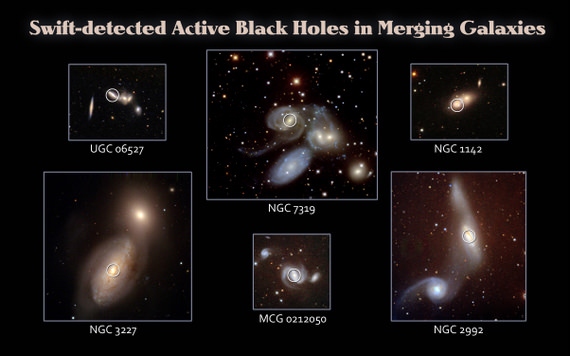Only about 1% of supermassive black holes emit large amounts of energy, and astronomers have wondered for decades why so few exhibit this behavior. Data from Swift satellite, which normally studies gamma ray bursts, has allowed scientists to confirm that black holes “light up” when galaxies collide, and the data may offer insight into the future behavior of the black hole in our own Milky Way galaxy.
The intense emission from galaxy centers, or nuclei, arises near a supermassive black hole containing between a million and a billion times the sun’s mass. Giving off as much as 10 billion times the sun’s energy, some of these active galactic nuclei (AGN) are the most luminous objects in the universe. They include quasars and blazars.
“Theorists have shown that the violence in galaxy mergers can feed a galaxy’s central black hole,” said Michael Koss, the study’s lead author and a graduate student at the University of Maryland in College Park. “The study elegantly explains how the black holes switched on.”
Swift was launched in 2004, and while its Burst Alert Telescope (BAT) is waiting to detect the next gamma ray burst, it also has been mapping the sky using hard X-rays, said Neil Gehrels, Swift’s principal investigator. “In fact, it detected its 508th gamma ray burst about 30 minutes ago,” Gehrels said at the press conference the morning of May 26th at the 216th meeting of the American Astronomical Society. “But building up its exposure year after year, the Swift BAT Hard X-ray Survey is the largest, most sensitive and complete census of the sky at these energies.”
Until this hard X-ray survey, astronomers never could be sure they had counted the majority of the AGN. Thick clouds of dust and gas surround the black hole in an active galaxy, which can block ultraviolet, optical and low-energy, or soft X-ray, light. Infrared radiation from warm dust near the black hole can pass through the material, but it can be confused with emissions from the galaxy’s star-forming regions. Hard X-rays can help scientists directly detect the energetic black hole.
[/caption]
The survey, which is sensitive to AGN as far as 650 million light-years away, uncovered dozens of previously unrecognized systems.
“The Swift BAT survey is giving us a very different picture of AGN,” Koss said. The team finds that about a quarter of the BAT galaxies are in mergers or close pairs. “Perhaps 60 percent of these galaxies will completely merge in the next billion years. We think we have the ‘smoking gun’ for merger-triggered AGN that theorists have predicted.”
“A big problem in astronomy is understanding how black holes grow and are fed,” said Joel Bregman from the University of Michigan. “We know growth in the early stages of a black hole’s life is a combination of mergers plus accretion of gas and dust from nearby stars, and we think that the accretion is the more important process. But this shows us that the feeding of the gas and dust has been channeled into the center at a fairly early stage, and the disturbance from the mergers allows gas to be funneled into the center and flow into the black hole.”
“We’ve never seen the onset of AGN activity so clearly,” said Bregman, who was not involved in the study. “The Swift team must be identifying an early stage of the process with the Hard X-ray Survey.”
Other members of the study team include Richard Mushotzky and Sylvain Veilleux at the University of Maryland and Lisa Winter at the Center for Astrophysics and Space Astronomy at the University of Colorado in Boulder.
The study will appear in the June 20 issue of The Astrophysical Journal Letters.
Source: NASA, NASA press conference


The simulation seems to show the two galaxies being obliterated. I presume that in this process there is a surge of X-ray and gamma ray activity near the BHs.
LC
It appeared that just before the giving off of light, the stars in the two galaxies were more compressed, enhancing the gravitational forces within the galaxies and ‘feeding’ more and more to the black holes. Could this have possibly saturated the gravitational fields of the black holes and thereby weakened them enough so that these x- and gamma rays could escape?
The black holes can only grow more massive and their gravity fields more extensive. What changes is the amount of material around them which interacts in various ways. The enhanced accretion of material onto the BHs is what increases the X-ray and gamma ray flux.
LC